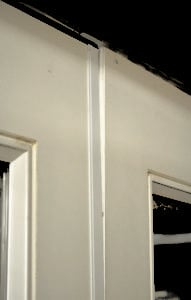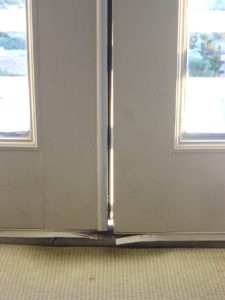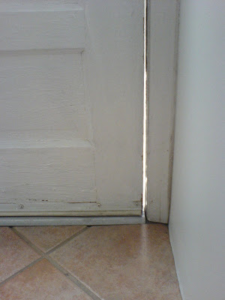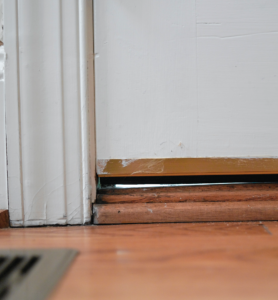Sealing and protecting your door from air and water infiltration is an extremely important part of your home’s maintenance. Air and water leaks can affect your utility bills, and light may extend an unknown invitation to small critters looking for a place to stay. There are 4 major areas to keep an eye on when checking for leaks around your door, and tell-tale signs that let you know it’s time for an update.
When proper sealing stops leaks and other challenges, you won’t need to spend time worrying about your home’s door health. Check out these 4 major areas around your door where leaks can occur.
Upper Corners
When a door leaks, the most common suspect is the bottom corner of the unit. However, in some instances, the top corner of the door is the true culprit. Whether your door is sagging or bowed, or just not making proper contact with the weatherstrip to seal out air and water, the upper corners of your frame could be the problem. moisture could be seeping into your home from the top.
Quick fix: The Simple Corner can increase contact and provide a tighter seal. Installation is quick, and no tools are needed!

Along the Jambs or In Between French Doors
The weatherstrip provides consistent compressed seal and is usually designed of soft, flexible material that wicks moisture around your door. Weatherstrips protect against air and moisture infiltration, and can be purchased in a variety of materials and colors. When weatherstrips begin to age, the material may tear of become so compressed that the strip no longer seals. Can you see light around your closed door panel? Is water leaking inside your home? It may be time to reinstall your weatherstripping.
Quick Fix: Weatherstrips come in a variety of different styles and sizes. To find your perfect weatherstrip, check out our Weatherstrip Selection Guide.

Crucial Corners
Is your crucial corner in need of some TLC? Located at the bottom corners of your door frame, the crucial corner is the most important area around your exterior door. Gaps between your door panel and door jamb may occur as your house settles or as corner pads go missing, but sealing well here can deliver noticeable improvements to your door performance. Due to gravity, the crucial corners tend to take the blame for leaks, even if they truly aren’t the source of the problem. Although leaks are extremely common in these areas and sometimes allow rain water, air and light into your home, a sealed crucial corner won’t fix a leak issue in other areas of the door.
Quick Fix: Simply remove the corner pad’s adhesive backing and stick the small, square pad to the insides of your door frame at the crucial corners. Learn more about updating your corner pads and check out our Corner Pad Installation Project Guide.

Photo Credit: talesfromtamarind.blogspot.co
Beneath the Door
If your door bottom is worn or needs replacing, you’ll likely be able to tell. Cold drafts, insects and visible light beneath a closed door panel are all signs that your door bottom may need to be replaced. Door bottoms tend wear over time, and sometimes our furry family members may help themselves to the new-found “chew toy”. Door bottoms seal between the panel and door sill, so watch for signs when your door bottom needs replacing.
Quick Fix: Door bottoms are important, but leaks can also be caused by the door sill. Even brand-new door bottoms won’t create a secure seal if your door sill isn’t properly adjusted. Alternatively, check your sill adjustment to close any gaps beneath your door panel.


